Global supply chain Management and Logistics
VerifiedAdded on 2022/03/25
|12
|2899
|22
AI Summary
The majority of companies involved in the value chain choose suppliers based on price and quality. Even though both of these factors are important, relationships with suppliers have become even more important with the evolving markets and external factors affecting these markets.
Contribute Materials
Your contribution can guide someone’s learning journey. Share your
documents today.

Is effective Supply Chain Management the key to real
Customer Value.
MN5547
Global supply chain Management and Logistics
Module Tutor: Dr Susan Grant
Vishnu Varma Penmetsa
1825656
1
Customer Value.
MN5547
Global supply chain Management and Logistics
Module Tutor: Dr Susan Grant
Vishnu Varma Penmetsa
1825656
1
Secure Best Marks with AI Grader
Need help grading? Try our AI Grader for instant feedback on your assignments.

“If you don’t have an essential item that puts people
into chaos. What happens if the coffee runs out in the
morning? Simple but you get the picture.”
~ EverythingSupplyChain.com
2
into chaos. What happens if the coffee runs out in the
morning? Simple but you get the picture.”
~ EverythingSupplyChain.com
2
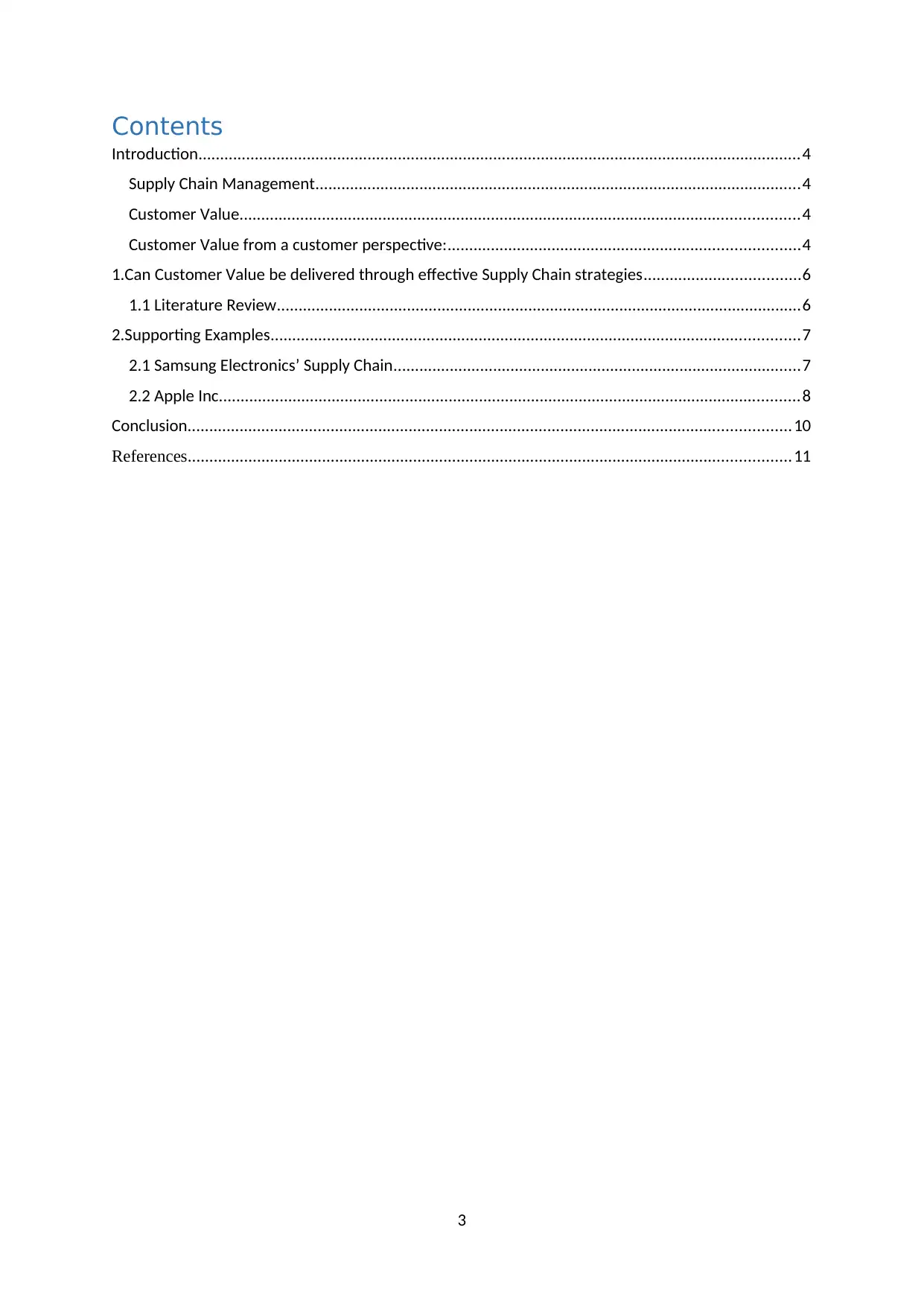
Contents
Introduction...........................................................................................................................................4
Supply Chain Management................................................................................................................4
Customer Value.................................................................................................................................4
Customer Value from a customer perspective:.................................................................................4
1.Can Customer Value be delivered through effective Supply Chain strategies....................................6
1.1 Literature Review.........................................................................................................................6
2.Supporting Examples..........................................................................................................................7
2.1 Samsung Electronics’ Supply Chain..............................................................................................7
2.2 Apple Inc......................................................................................................................................8
Conclusion...........................................................................................................................................10
References...........................................................................................................................................11
3
Introduction...........................................................................................................................................4
Supply Chain Management................................................................................................................4
Customer Value.................................................................................................................................4
Customer Value from a customer perspective:.................................................................................4
1.Can Customer Value be delivered through effective Supply Chain strategies....................................6
1.1 Literature Review.........................................................................................................................6
2.Supporting Examples..........................................................................................................................7
2.1 Samsung Electronics’ Supply Chain..............................................................................................7
2.2 Apple Inc......................................................................................................................................8
Conclusion...........................................................................................................................................10
References...........................................................................................................................................11
3
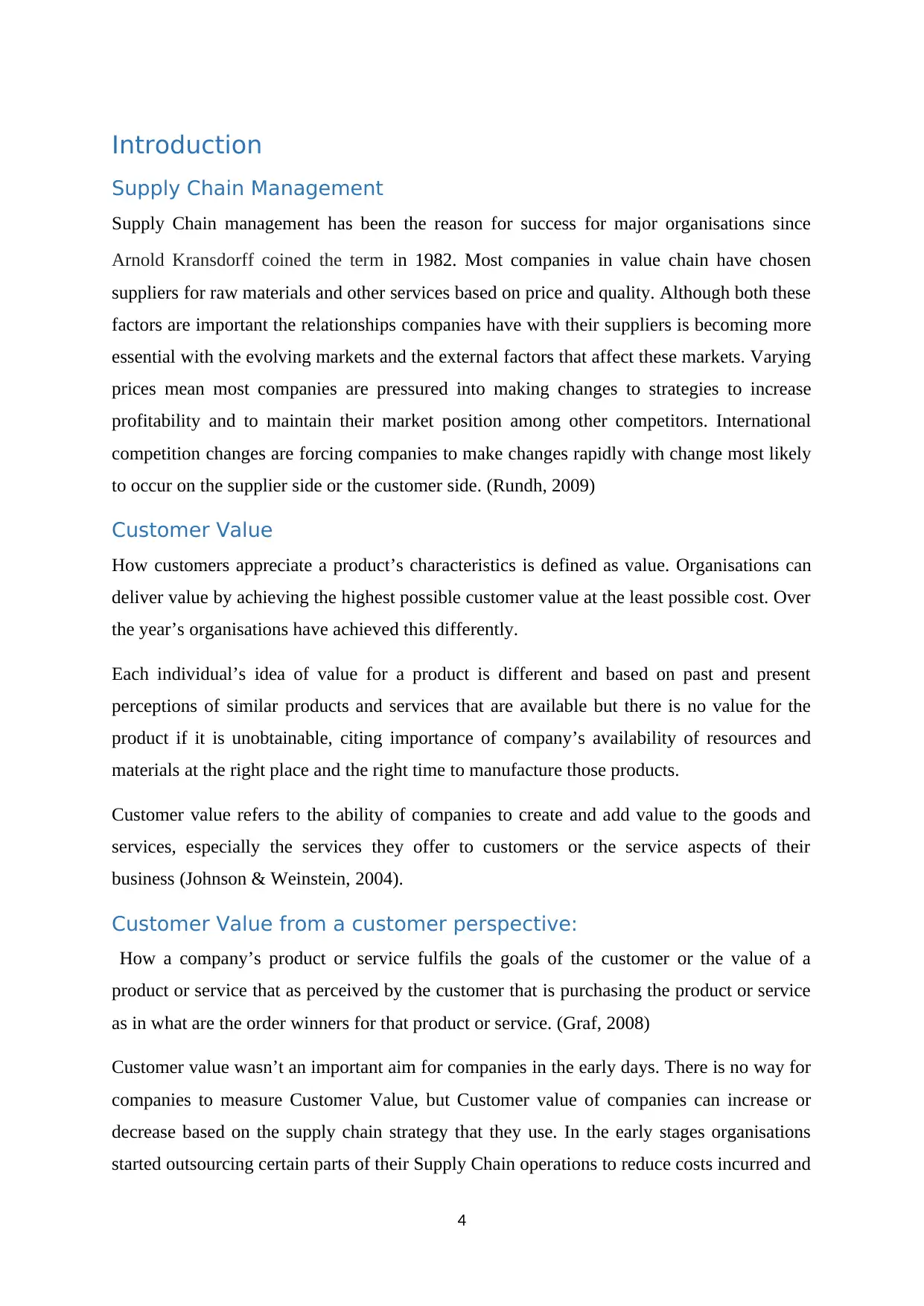
Introduction
Supply Chain Management
Supply Chain management has been the reason for success for major organisations since
Arnold Kransdorff coined the term in 1982. Most companies in value chain have chosen
suppliers for raw materials and other services based on price and quality. Although both these
factors are important the relationships companies have with their suppliers is becoming more
essential with the evolving markets and the external factors that affect these markets. Varying
prices mean most companies are pressured into making changes to strategies to increase
profitability and to maintain their market position among other competitors. International
competition changes are forcing companies to make changes rapidly with change most likely
to occur on the supplier side or the customer side. (Rundh, 2009)
Customer Value
How customers appreciate a product’s characteristics is defined as value. Organisations can
deliver value by achieving the highest possible customer value at the least possible cost. Over
the year’s organisations have achieved this differently.
Each individual’s idea of value for a product is different and based on past and present
perceptions of similar products and services that are available but there is no value for the
product if it is unobtainable, citing importance of company’s availability of resources and
materials at the right place and the right time to manufacture those products.
Customer value refers to the ability of companies to create and add value to the goods and
services, especially the services they offer to customers or the service aspects of their
business (Johnson & Weinstein, 2004).
Customer Value from a customer perspective:
How a company’s product or service fulfils the goals of the customer or the value of a
product or service that as perceived by the customer that is purchasing the product or service
as in what are the order winners for that product or service. (Graf, 2008)
Customer value wasn’t an important aim for companies in the early days. There is no way for
companies to measure Customer Value, but Customer value of companies can increase or
decrease based on the supply chain strategy that they use. In the early stages organisations
started outsourcing certain parts of their Supply Chain operations to reduce costs incurred and
4
Supply Chain Management
Supply Chain management has been the reason for success for major organisations since
Arnold Kransdorff coined the term in 1982. Most companies in value chain have chosen
suppliers for raw materials and other services based on price and quality. Although both these
factors are important the relationships companies have with their suppliers is becoming more
essential with the evolving markets and the external factors that affect these markets. Varying
prices mean most companies are pressured into making changes to strategies to increase
profitability and to maintain their market position among other competitors. International
competition changes are forcing companies to make changes rapidly with change most likely
to occur on the supplier side or the customer side. (Rundh, 2009)
Customer Value
How customers appreciate a product’s characteristics is defined as value. Organisations can
deliver value by achieving the highest possible customer value at the least possible cost. Over
the year’s organisations have achieved this differently.
Each individual’s idea of value for a product is different and based on past and present
perceptions of similar products and services that are available but there is no value for the
product if it is unobtainable, citing importance of company’s availability of resources and
materials at the right place and the right time to manufacture those products.
Customer value refers to the ability of companies to create and add value to the goods and
services, especially the services they offer to customers or the service aspects of their
business (Johnson & Weinstein, 2004).
Customer Value from a customer perspective:
How a company’s product or service fulfils the goals of the customer or the value of a
product or service that as perceived by the customer that is purchasing the product or service
as in what are the order winners for that product or service. (Graf, 2008)
Customer value wasn’t an important aim for companies in the early days. There is no way for
companies to measure Customer Value, but Customer value of companies can increase or
decrease based on the supply chain strategy that they use. In the early stages organisations
started outsourcing certain parts of their Supply Chain operations to reduce costs incurred and
4
Paraphrase This Document
Need a fresh take? Get an instant paraphrase of this document with our AI Paraphraser
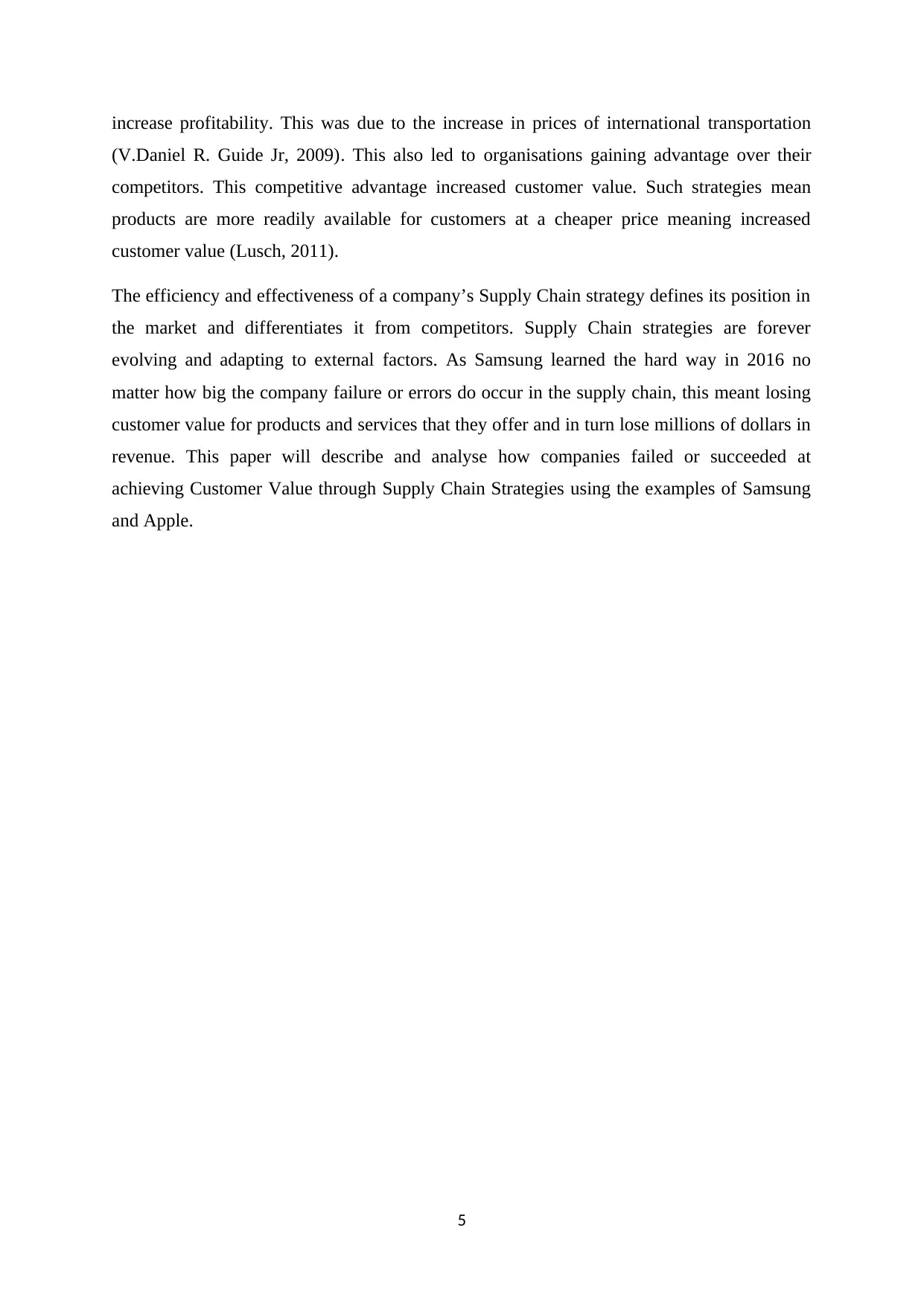
increase profitability. This was due to the increase in prices of international transportation
(V.Daniel R. Guide Jr, 2009). This also led to organisations gaining advantage over their
competitors. This competitive advantage increased customer value. Such strategies mean
products are more readily available for customers at a cheaper price meaning increased
customer value (Lusch, 2011).
The efficiency and effectiveness of a company’s Supply Chain strategy defines its position in
the market and differentiates it from competitors. Supply Chain strategies are forever
evolving and adapting to external factors. As Samsung learned the hard way in 2016 no
matter how big the company failure or errors do occur in the supply chain, this meant losing
customer value for products and services that they offer and in turn lose millions of dollars in
revenue. This paper will describe and analyse how companies failed or succeeded at
achieving Customer Value through Supply Chain Strategies using the examples of Samsung
and Apple.
5
(V.Daniel R. Guide Jr, 2009). This also led to organisations gaining advantage over their
competitors. This competitive advantage increased customer value. Such strategies mean
products are more readily available for customers at a cheaper price meaning increased
customer value (Lusch, 2011).
The efficiency and effectiveness of a company’s Supply Chain strategy defines its position in
the market and differentiates it from competitors. Supply Chain strategies are forever
evolving and adapting to external factors. As Samsung learned the hard way in 2016 no
matter how big the company failure or errors do occur in the supply chain, this meant losing
customer value for products and services that they offer and in turn lose millions of dollars in
revenue. This paper will describe and analyse how companies failed or succeeded at
achieving Customer Value through Supply Chain Strategies using the examples of Samsung
and Apple.
5
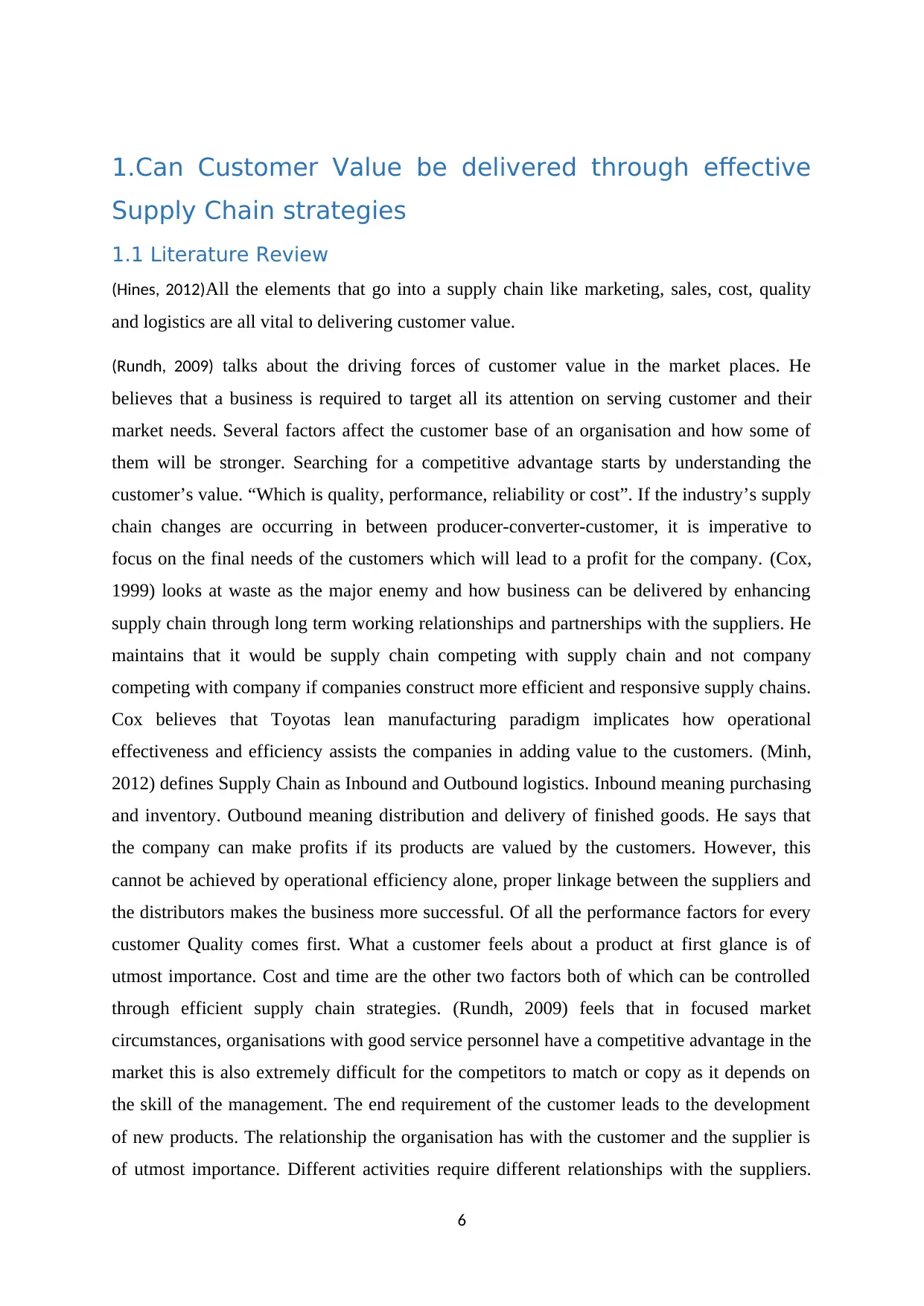
1.Can Customer Value be delivered through effective
Supply Chain strategies
1.1 Literature Review
(Hines, 2012)All the elements that go into a supply chain like marketing, sales, cost, quality
and logistics are all vital to delivering customer value.
(Rundh, 2009) talks about the driving forces of customer value in the market places. He
believes that a business is required to target all its attention on serving customer and their
market needs. Several factors affect the customer base of an organisation and how some of
them will be stronger. Searching for a competitive advantage starts by understanding the
customer’s value. “Which is quality, performance, reliability or cost”. If the industry’s supply
chain changes are occurring in between producer-converter-customer, it is imperative to
focus on the final needs of the customers which will lead to a profit for the company. (Cox,
1999) looks at waste as the major enemy and how business can be delivered by enhancing
supply chain through long term working relationships and partnerships with the suppliers. He
maintains that it would be supply chain competing with supply chain and not company
competing with company if companies construct more efficient and responsive supply chains.
Cox believes that Toyotas lean manufacturing paradigm implicates how operational
effectiveness and efficiency assists the companies in adding value to the customers. (Minh,
2012) defines Supply Chain as Inbound and Outbound logistics. Inbound meaning purchasing
and inventory. Outbound meaning distribution and delivery of finished goods. He says that
the company can make profits if its products are valued by the customers. However, this
cannot be achieved by operational efficiency alone, proper linkage between the suppliers and
the distributors makes the business more successful. Of all the performance factors for every
customer Quality comes first. What a customer feels about a product at first glance is of
utmost importance. Cost and time are the other two factors both of which can be controlled
through efficient supply chain strategies. (Rundh, 2009) feels that in focused market
circumstances, organisations with good service personnel have a competitive advantage in the
market this is also extremely difficult for the competitors to match or copy as it depends on
the skill of the management. The end requirement of the customer leads to the development
of new products. The relationship the organisation has with the customer and the supplier is
of utmost importance. Different activities require different relationships with the suppliers.
6
Supply Chain strategies
1.1 Literature Review
(Hines, 2012)All the elements that go into a supply chain like marketing, sales, cost, quality
and logistics are all vital to delivering customer value.
(Rundh, 2009) talks about the driving forces of customer value in the market places. He
believes that a business is required to target all its attention on serving customer and their
market needs. Several factors affect the customer base of an organisation and how some of
them will be stronger. Searching for a competitive advantage starts by understanding the
customer’s value. “Which is quality, performance, reliability or cost”. If the industry’s supply
chain changes are occurring in between producer-converter-customer, it is imperative to
focus on the final needs of the customers which will lead to a profit for the company. (Cox,
1999) looks at waste as the major enemy and how business can be delivered by enhancing
supply chain through long term working relationships and partnerships with the suppliers. He
maintains that it would be supply chain competing with supply chain and not company
competing with company if companies construct more efficient and responsive supply chains.
Cox believes that Toyotas lean manufacturing paradigm implicates how operational
effectiveness and efficiency assists the companies in adding value to the customers. (Minh,
2012) defines Supply Chain as Inbound and Outbound logistics. Inbound meaning purchasing
and inventory. Outbound meaning distribution and delivery of finished goods. He says that
the company can make profits if its products are valued by the customers. However, this
cannot be achieved by operational efficiency alone, proper linkage between the suppliers and
the distributors makes the business more successful. Of all the performance factors for every
customer Quality comes first. What a customer feels about a product at first glance is of
utmost importance. Cost and time are the other two factors both of which can be controlled
through efficient supply chain strategies. (Rundh, 2009) feels that in focused market
circumstances, organisations with good service personnel have a competitive advantage in the
market this is also extremely difficult for the competitors to match or copy as it depends on
the skill of the management. The end requirement of the customer leads to the development
of new products. The relationship the organisation has with the customer and the supplier is
of utmost importance. Different activities require different relationships with the suppliers.
6
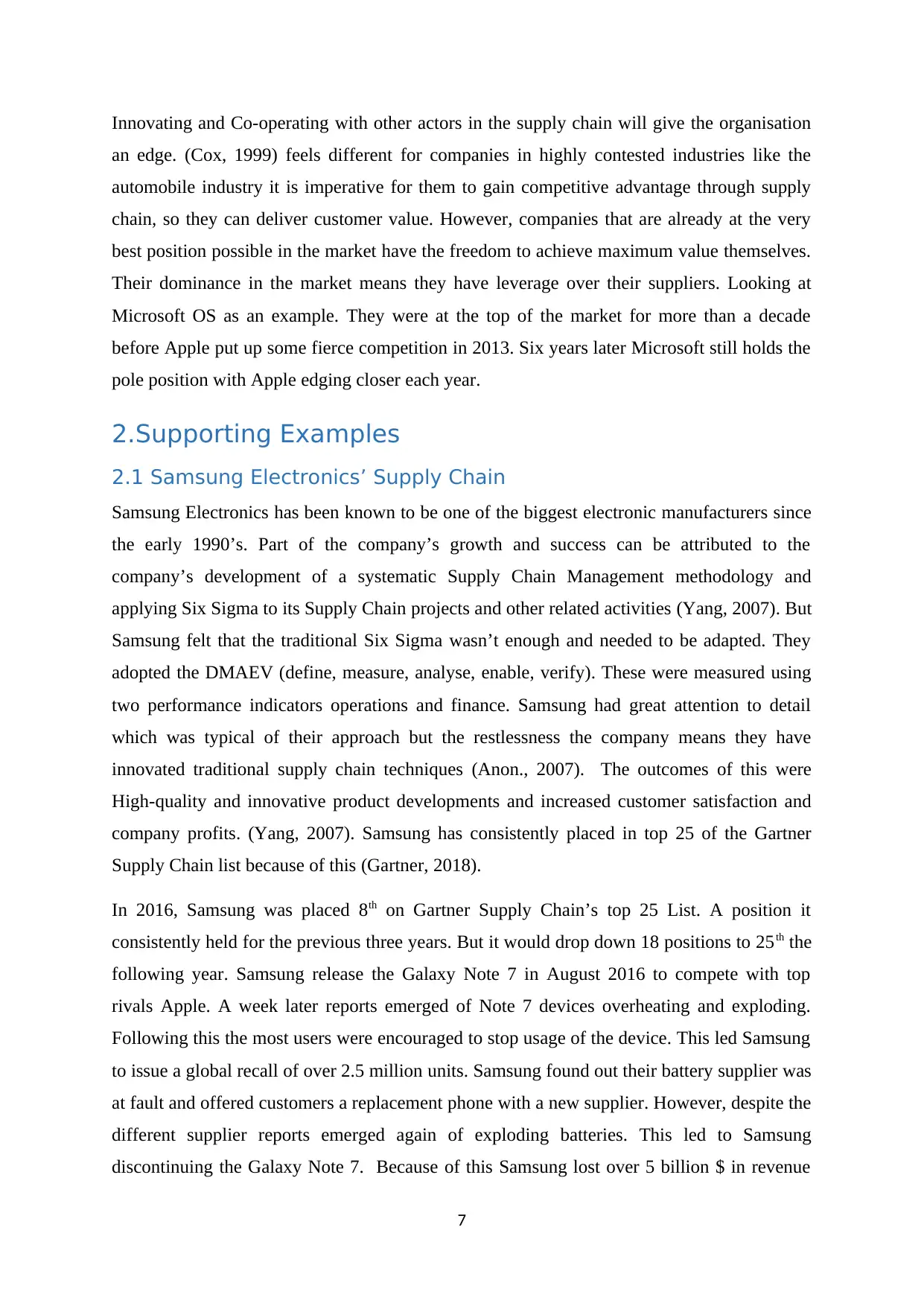
Innovating and Co-operating with other actors in the supply chain will give the organisation
an edge. (Cox, 1999) feels different for companies in highly contested industries like the
automobile industry it is imperative for them to gain competitive advantage through supply
chain, so they can deliver customer value. However, companies that are already at the very
best position possible in the market have the freedom to achieve maximum value themselves.
Their dominance in the market means they have leverage over their suppliers. Looking at
Microsoft OS as an example. They were at the top of the market for more than a decade
before Apple put up some fierce competition in 2013. Six years later Microsoft still holds the
pole position with Apple edging closer each year.
2.Supporting Examples
2.1 Samsung Electronics’ Supply Chain
Samsung Electronics has been known to be one of the biggest electronic manufacturers since
the early 1990’s. Part of the company’s growth and success can be attributed to the
company’s development of a systematic Supply Chain Management methodology and
applying Six Sigma to its Supply Chain projects and other related activities (Yang, 2007). But
Samsung felt that the traditional Six Sigma wasn’t enough and needed to be adapted. They
adopted the DMAEV (define, measure, analyse, enable, verify). These were measured using
two performance indicators operations and finance. Samsung had great attention to detail
which was typical of their approach but the restlessness the company means they have
innovated traditional supply chain techniques (Anon., 2007). The outcomes of this were
High-quality and innovative product developments and increased customer satisfaction and
company profits. (Yang, 2007). Samsung has consistently placed in top 25 of the Gartner
Supply Chain list because of this (Gartner, 2018).
In 2016, Samsung was placed 8th on Gartner Supply Chain’s top 25 List. A position it
consistently held for the previous three years. But it would drop down 18 positions to 25th the
following year. Samsung release the Galaxy Note 7 in August 2016 to compete with top
rivals Apple. A week later reports emerged of Note 7 devices overheating and exploding.
Following this the most users were encouraged to stop usage of the device. This led Samsung
to issue a global recall of over 2.5 million units. Samsung found out their battery supplier was
at fault and offered customers a replacement phone with a new supplier. However, despite the
different supplier reports emerged again of exploding batteries. This led to Samsung
discontinuing the Galaxy Note 7. Because of this Samsung lost over 5 billion $ in revenue
7
an edge. (Cox, 1999) feels different for companies in highly contested industries like the
automobile industry it is imperative for them to gain competitive advantage through supply
chain, so they can deliver customer value. However, companies that are already at the very
best position possible in the market have the freedom to achieve maximum value themselves.
Their dominance in the market means they have leverage over their suppliers. Looking at
Microsoft OS as an example. They were at the top of the market for more than a decade
before Apple put up some fierce competition in 2013. Six years later Microsoft still holds the
pole position with Apple edging closer each year.
2.Supporting Examples
2.1 Samsung Electronics’ Supply Chain
Samsung Electronics has been known to be one of the biggest electronic manufacturers since
the early 1990’s. Part of the company’s growth and success can be attributed to the
company’s development of a systematic Supply Chain Management methodology and
applying Six Sigma to its Supply Chain projects and other related activities (Yang, 2007). But
Samsung felt that the traditional Six Sigma wasn’t enough and needed to be adapted. They
adopted the DMAEV (define, measure, analyse, enable, verify). These were measured using
two performance indicators operations and finance. Samsung had great attention to detail
which was typical of their approach but the restlessness the company means they have
innovated traditional supply chain techniques (Anon., 2007). The outcomes of this were
High-quality and innovative product developments and increased customer satisfaction and
company profits. (Yang, 2007). Samsung has consistently placed in top 25 of the Gartner
Supply Chain list because of this (Gartner, 2018).
In 2016, Samsung was placed 8th on Gartner Supply Chain’s top 25 List. A position it
consistently held for the previous three years. But it would drop down 18 positions to 25th the
following year. Samsung release the Galaxy Note 7 in August 2016 to compete with top
rivals Apple. A week later reports emerged of Note 7 devices overheating and exploding.
Following this the most users were encouraged to stop usage of the device. This led Samsung
to issue a global recall of over 2.5 million units. Samsung found out their battery supplier was
at fault and offered customers a replacement phone with a new supplier. However, despite the
different supplier reports emerged again of exploding batteries. This led to Samsung
discontinuing the Galaxy Note 7. Because of this Samsung lost over 5 billion $ in revenue
7
Secure Best Marks with AI Grader
Need help grading? Try our AI Grader for instant feedback on your assignments.
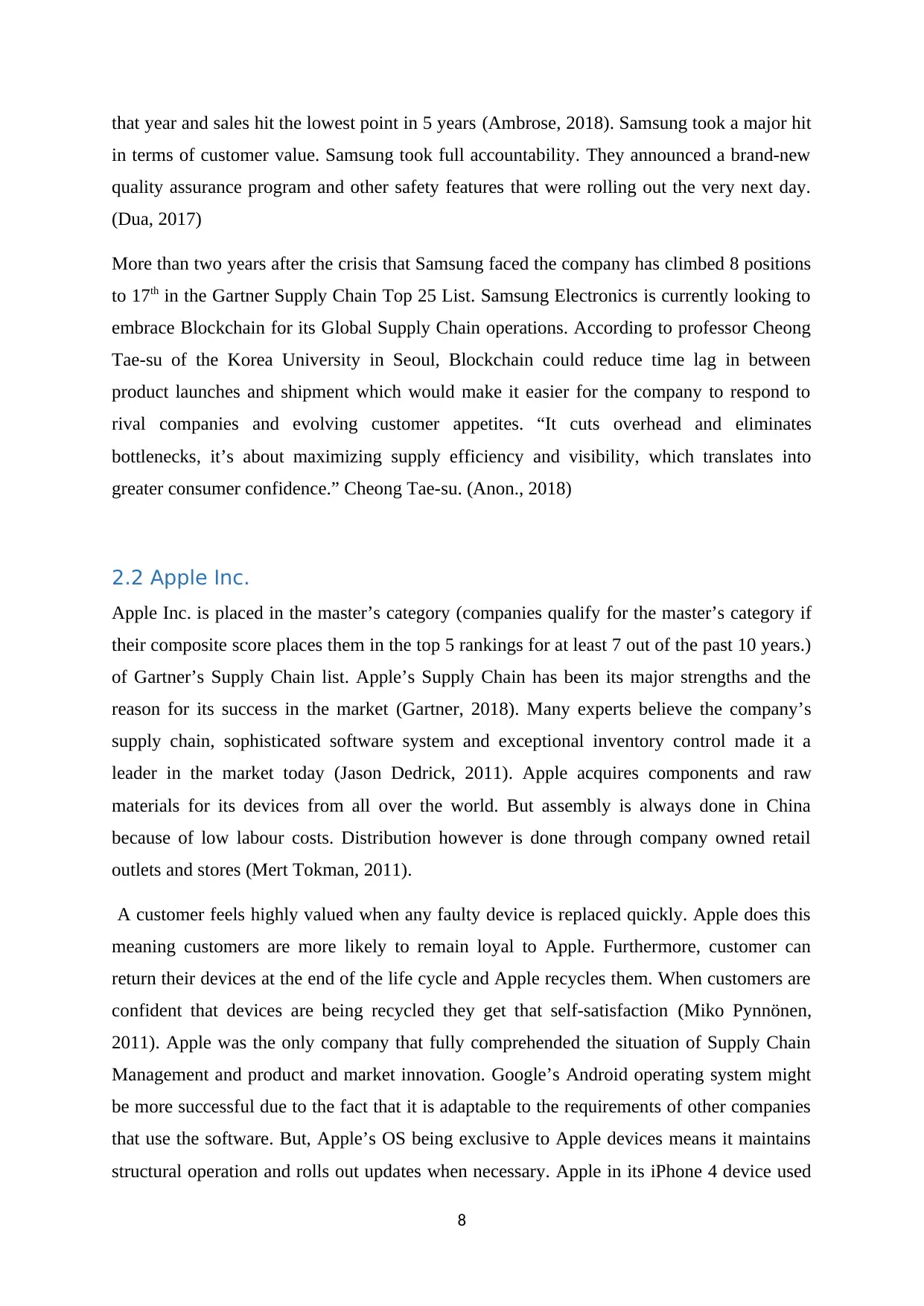
that year and sales hit the lowest point in 5 years (Ambrose, 2018). Samsung took a major hit
in terms of customer value. Samsung took full accountability. They announced a brand-new
quality assurance program and other safety features that were rolling out the very next day.
(Dua, 2017)
More than two years after the crisis that Samsung faced the company has climbed 8 positions
to 17th in the Gartner Supply Chain Top 25 List. Samsung Electronics is currently looking to
embrace Blockchain for its Global Supply Chain operations. According to professor Cheong
Tae-su of the Korea University in Seoul, Blockchain could reduce time lag in between
product launches and shipment which would make it easier for the company to respond to
rival companies and evolving customer appetites. “It cuts overhead and eliminates
bottlenecks, it’s about maximizing supply efficiency and visibility, which translates into
greater consumer confidence.” Cheong Tae-su. (Anon., 2018)
2.2 Apple Inc.
Apple Inc. is placed in the master’s category (companies qualify for the master’s category if
their composite score places them in the top 5 rankings for at least 7 out of the past 10 years.)
of Gartner’s Supply Chain list. Apple’s Supply Chain has been its major strengths and the
reason for its success in the market (Gartner, 2018). Many experts believe the company’s
supply chain, sophisticated software system and exceptional inventory control made it a
leader in the market today (Jason Dedrick, 2011). Apple acquires components and raw
materials for its devices from all over the world. But assembly is always done in China
because of low labour costs. Distribution however is done through company owned retail
outlets and stores (Mert Tokman, 2011).
A customer feels highly valued when any faulty device is replaced quickly. Apple does this
meaning customers are more likely to remain loyal to Apple. Furthermore, customer can
return their devices at the end of the life cycle and Apple recycles them. When customers are
confident that devices are being recycled they get that self-satisfaction (Miko Pynnönen,
2011). Apple was the only company that fully comprehended the situation of Supply Chain
Management and product and market innovation. Google’s Android operating system might
be more successful due to the fact that it is adaptable to the requirements of other companies
that use the software. But, Apple’s OS being exclusive to Apple devices means it maintains
structural operation and rolls out updates when necessary. Apple in its iPhone 4 device used
8
in terms of customer value. Samsung took full accountability. They announced a brand-new
quality assurance program and other safety features that were rolling out the very next day.
(Dua, 2017)
More than two years after the crisis that Samsung faced the company has climbed 8 positions
to 17th in the Gartner Supply Chain Top 25 List. Samsung Electronics is currently looking to
embrace Blockchain for its Global Supply Chain operations. According to professor Cheong
Tae-su of the Korea University in Seoul, Blockchain could reduce time lag in between
product launches and shipment which would make it easier for the company to respond to
rival companies and evolving customer appetites. “It cuts overhead and eliminates
bottlenecks, it’s about maximizing supply efficiency and visibility, which translates into
greater consumer confidence.” Cheong Tae-su. (Anon., 2018)
2.2 Apple Inc.
Apple Inc. is placed in the master’s category (companies qualify for the master’s category if
their composite score places them in the top 5 rankings for at least 7 out of the past 10 years.)
of Gartner’s Supply Chain list. Apple’s Supply Chain has been its major strengths and the
reason for its success in the market (Gartner, 2018). Many experts believe the company’s
supply chain, sophisticated software system and exceptional inventory control made it a
leader in the market today (Jason Dedrick, 2011). Apple acquires components and raw
materials for its devices from all over the world. But assembly is always done in China
because of low labour costs. Distribution however is done through company owned retail
outlets and stores (Mert Tokman, 2011).
A customer feels highly valued when any faulty device is replaced quickly. Apple does this
meaning customers are more likely to remain loyal to Apple. Furthermore, customer can
return their devices at the end of the life cycle and Apple recycles them. When customers are
confident that devices are being recycled they get that self-satisfaction (Miko Pynnönen,
2011). Apple was the only company that fully comprehended the situation of Supply Chain
Management and product and market innovation. Google’s Android operating system might
be more successful due to the fact that it is adaptable to the requirements of other companies
that use the software. But, Apple’s OS being exclusive to Apple devices means it maintains
structural operation and rolls out updates when necessary. Apple in its iPhone 4 device used
8
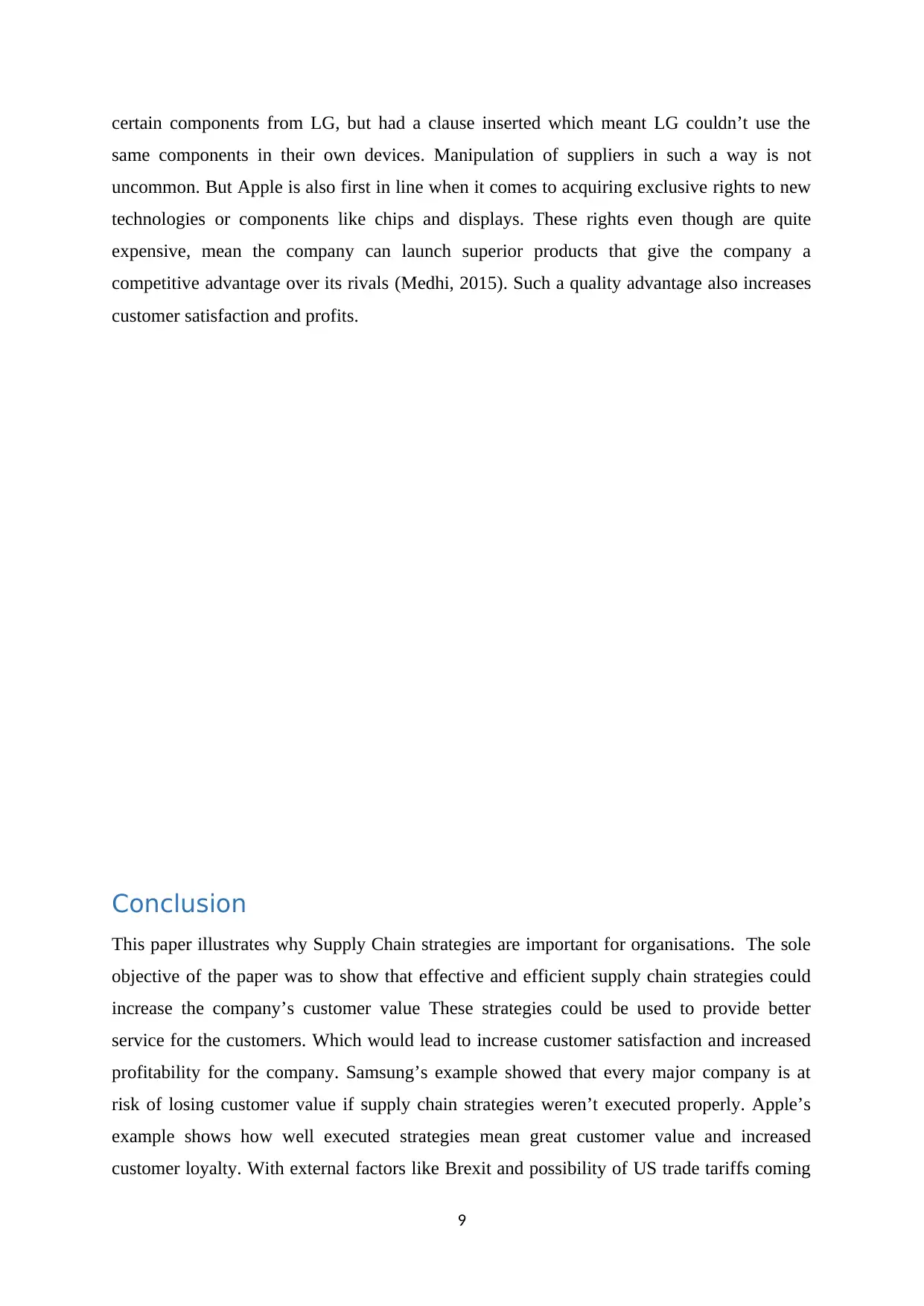
certain components from LG, but had a clause inserted which meant LG couldn’t use the
same components in their own devices. Manipulation of suppliers in such a way is not
uncommon. But Apple is also first in line when it comes to acquiring exclusive rights to new
technologies or components like chips and displays. These rights even though are quite
expensive, mean the company can launch superior products that give the company a
competitive advantage over its rivals (Medhi, 2015). Such a quality advantage also increases
customer satisfaction and profits.
Conclusion
This paper illustrates why Supply Chain strategies are important for organisations. The sole
objective of the paper was to show that effective and efficient supply chain strategies could
increase the company’s customer value These strategies could be used to provide better
service for the customers. Which would lead to increase customer satisfaction and increased
profitability for the company. Samsung’s example showed that every major company is at
risk of losing customer value if supply chain strategies weren’t executed properly. Apple’s
example shows how well executed strategies mean great customer value and increased
customer loyalty. With external factors like Brexit and possibility of US trade tariffs coming
9
same components in their own devices. Manipulation of suppliers in such a way is not
uncommon. But Apple is also first in line when it comes to acquiring exclusive rights to new
technologies or components like chips and displays. These rights even though are quite
expensive, mean the company can launch superior products that give the company a
competitive advantage over its rivals (Medhi, 2015). Such a quality advantage also increases
customer satisfaction and profits.
Conclusion
This paper illustrates why Supply Chain strategies are important for organisations. The sole
objective of the paper was to show that effective and efficient supply chain strategies could
increase the company’s customer value These strategies could be used to provide better
service for the customers. Which would lead to increase customer satisfaction and increased
profitability for the company. Samsung’s example showed that every major company is at
risk of losing customer value if supply chain strategies weren’t executed properly. Apple’s
example shows how well executed strategies mean great customer value and increased
customer loyalty. With external factors like Brexit and possibility of US trade tariffs coming
9
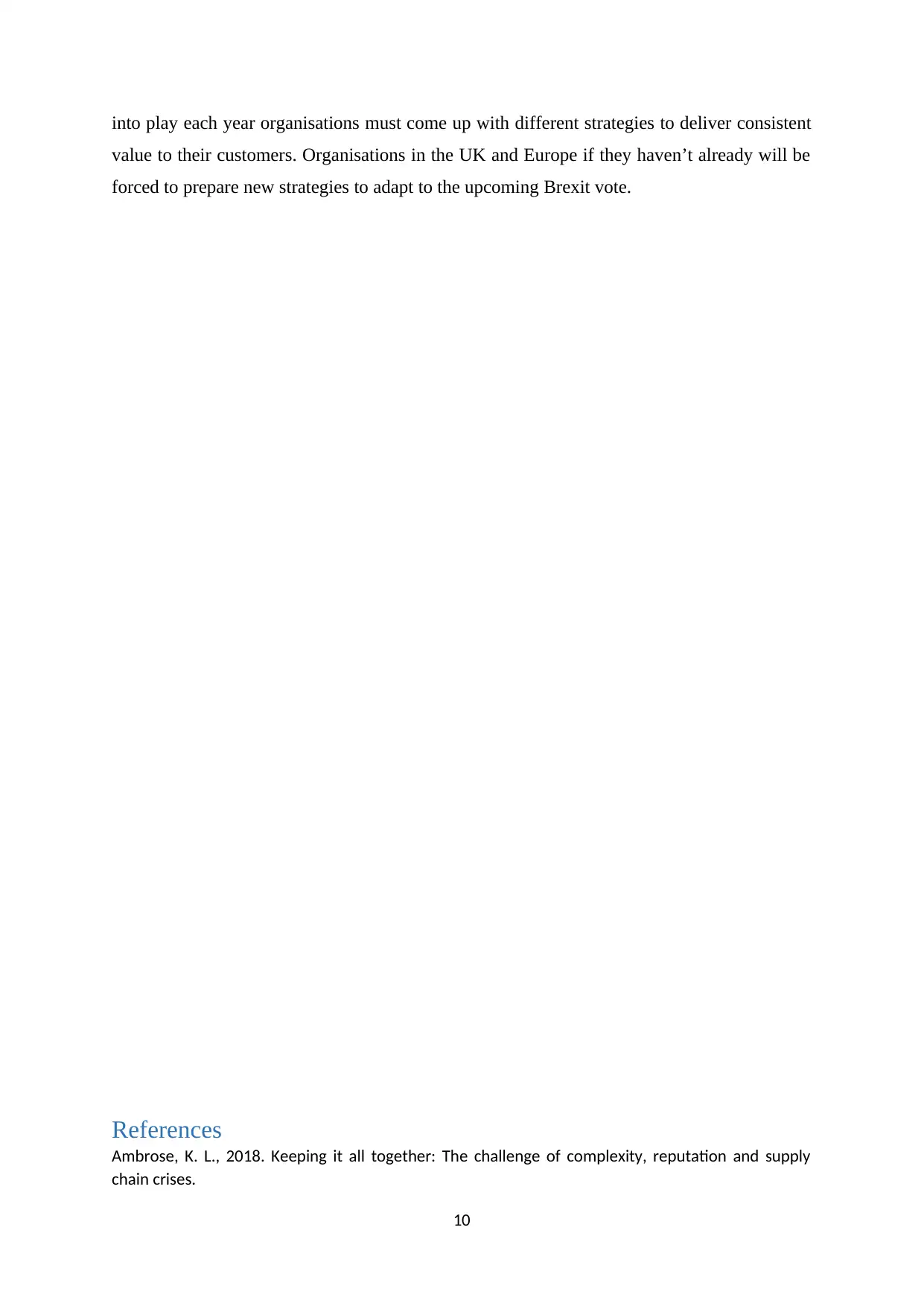
into play each year organisations must come up with different strategies to deliver consistent
value to their customers. Organisations in the UK and Europe if they haven’t already will be
forced to prepare new strategies to adapt to the upcoming Brexit vote.
References
Ambrose, K. L., 2018. Keeping it all together: The challenge of complexity, reputation and supply
chain crises.
10
value to their customers. Organisations in the UK and Europe if they haven’t already will be
forced to prepare new strategies to adapt to the upcoming Brexit vote.
References
Ambrose, K. L., 2018. Keeping it all together: The challenge of complexity, reputation and supply
chain crises.
10
Paraphrase This Document
Need a fresh take? Get an instant paraphrase of this document with our AI Paraphraser
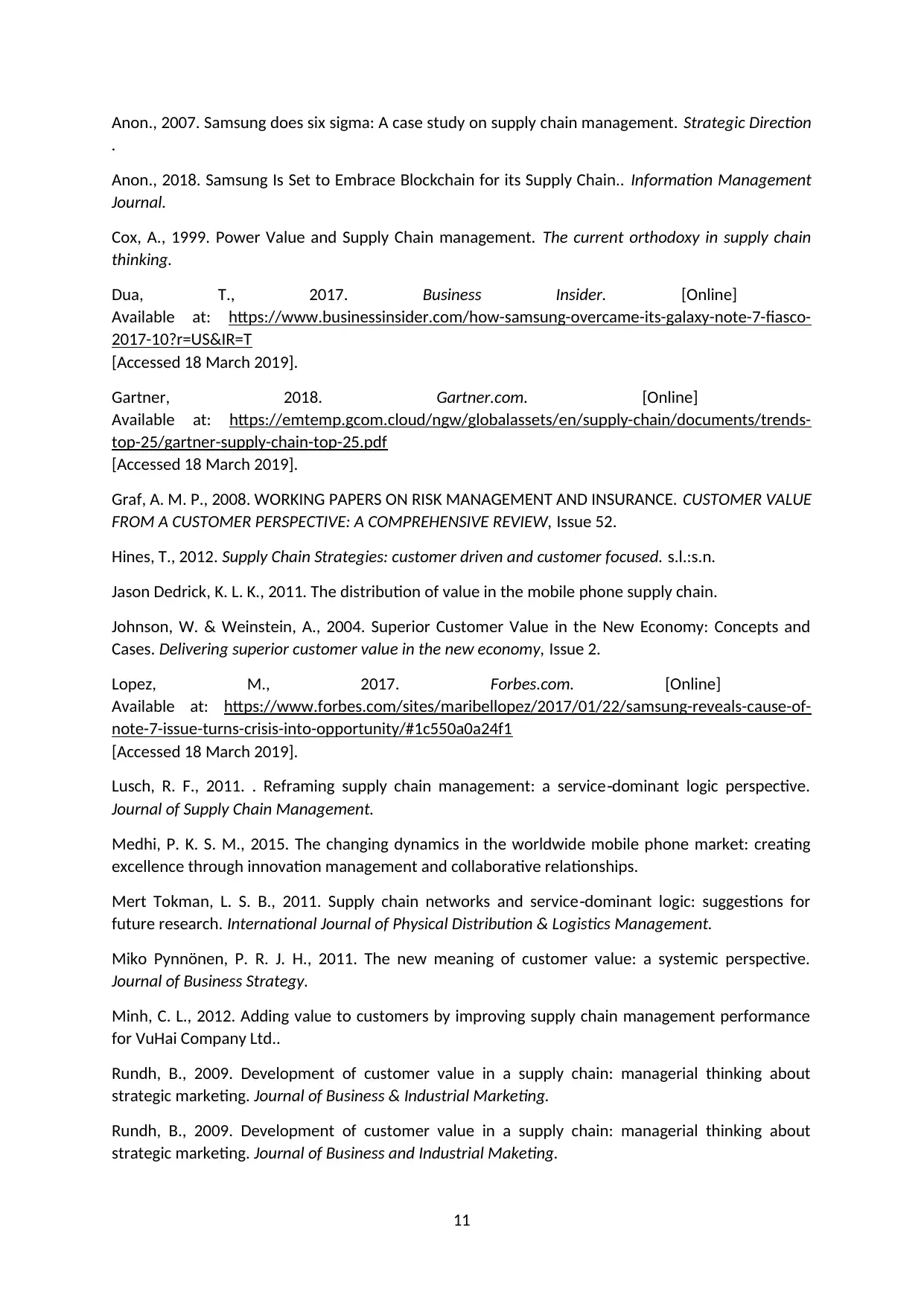
Anon., 2007. Samsung does six sigma: A case study on supply chain management. Strategic Direction
.
Anon., 2018. Samsung Is Set to Embrace Blockchain for its Supply Chain.. Information Management
Journal.
Cox, A., 1999. Power Value and Supply Chain management. The current orthodoxy in supply chain
thinking.
Dua, T., 2017. Business Insider. [Online]
Available at: https://www.businessinsider.com/how-samsung-overcame-its-galaxy-note-7-fiasco-
2017-10?r=US&IR=T
[Accessed 18 March 2019].
Gartner, 2018. Gartner.com. [Online]
Available at: https://emtemp.gcom.cloud/ngw/globalassets/en/supply-chain/documents/trends-
top-25/gartner-supply-chain-top-25.pdf
[Accessed 18 March 2019].
Graf, A. M. P., 2008. WORKING PAPERS ON RISK MANAGEMENT AND INSURANCE. CUSTOMER VALUE
FROM A CUSTOMER PERSPECTIVE: A COMPREHENSIVE REVIEW, Issue 52.
Hines, T., 2012. Supply Chain Strategies: customer driven and customer focused. s.l.:s.n.
Jason Dedrick, K. L. K., 2011. The distribution of value in the mobile phone supply chain.
Johnson, W. & Weinstein, A., 2004. Superior Customer Value in the New Economy: Concepts and
Cases. Delivering superior customer value in the new economy, Issue 2.
Lopez, M., 2017. Forbes.com. [Online]
Available at: https://www.forbes.com/sites/maribellopez/2017/01/22/samsung-reveals-cause-of-
note-7-issue-turns-crisis-into-opportunity/#1c550a0a24f1
[Accessed 18 March 2019].
Lusch, R. F., 2011. . Reframing supply chain management: a service dominant logic perspective.‐
Journal of Supply Chain Management.
Medhi, P. K. S. M., 2015. The changing dynamics in the worldwide mobile phone market: creating
excellence through innovation management and collaborative relationships.
Mert Tokman, L. S. B., 2011. Supply chain networks and service dominant logic: suggestions for‐
future research. International Journal of Physical Distribution & Logistics Management.
Miko Pynnönen, P. R. J. H., 2011. The new meaning of customer value: a systemic perspective.
Journal of Business Strategy.
Minh, C. L., 2012. Adding value to customers by improving supply chain management performance
for VuHai Company Ltd..
Rundh, B., 2009. Development of customer value in a supply chain: managerial thinking about
strategic marketing. Journal of Business & Industrial Marketing.
Rundh, B., 2009. Development of customer value in a supply chain: managerial thinking about
strategic marketing. Journal of Business and Industrial Maketing.
11
.
Anon., 2018. Samsung Is Set to Embrace Blockchain for its Supply Chain.. Information Management
Journal.
Cox, A., 1999. Power Value and Supply Chain management. The current orthodoxy in supply chain
thinking.
Dua, T., 2017. Business Insider. [Online]
Available at: https://www.businessinsider.com/how-samsung-overcame-its-galaxy-note-7-fiasco-
2017-10?r=US&IR=T
[Accessed 18 March 2019].
Gartner, 2018. Gartner.com. [Online]
Available at: https://emtemp.gcom.cloud/ngw/globalassets/en/supply-chain/documents/trends-
top-25/gartner-supply-chain-top-25.pdf
[Accessed 18 March 2019].
Graf, A. M. P., 2008. WORKING PAPERS ON RISK MANAGEMENT AND INSURANCE. CUSTOMER VALUE
FROM A CUSTOMER PERSPECTIVE: A COMPREHENSIVE REVIEW, Issue 52.
Hines, T., 2012. Supply Chain Strategies: customer driven and customer focused. s.l.:s.n.
Jason Dedrick, K. L. K., 2011. The distribution of value in the mobile phone supply chain.
Johnson, W. & Weinstein, A., 2004. Superior Customer Value in the New Economy: Concepts and
Cases. Delivering superior customer value in the new economy, Issue 2.
Lopez, M., 2017. Forbes.com. [Online]
Available at: https://www.forbes.com/sites/maribellopez/2017/01/22/samsung-reveals-cause-of-
note-7-issue-turns-crisis-into-opportunity/#1c550a0a24f1
[Accessed 18 March 2019].
Lusch, R. F., 2011. . Reframing supply chain management: a service dominant logic perspective.‐
Journal of Supply Chain Management.
Medhi, P. K. S. M., 2015. The changing dynamics in the worldwide mobile phone market: creating
excellence through innovation management and collaborative relationships.
Mert Tokman, L. S. B., 2011. Supply chain networks and service dominant logic: suggestions for‐
future research. International Journal of Physical Distribution & Logistics Management.
Miko Pynnönen, P. R. J. H., 2011. The new meaning of customer value: a systemic perspective.
Journal of Business Strategy.
Minh, C. L., 2012. Adding value to customers by improving supply chain management performance
for VuHai Company Ltd..
Rundh, B., 2009. Development of customer value in a supply chain: managerial thinking about
strategic marketing. Journal of Business & Industrial Marketing.
Rundh, B., 2009. Development of customer value in a supply chain: managerial thinking about
strategic marketing. Journal of Business and Industrial Maketing.
11

V.Daniel R. Guide Jr, L. N. V. W., 2009. The evolution of closed-loop supply chain research.
Operations Research.
Webb, J., 2017. Forbes. [Online]
Available at: https://www.forbes.com/sites/jwebb/2017/10/30/apples-supply-chain-attracts-
criticism-for-performance-but-also-praise-for-sustainability/#375313a67398
[Accessed 18 March 2019].
Yang, H. M., 2007. Supply chain management six sigma: a management innovation methodology at
the Samsung Group. Supply Chain Management: An International Journal.
12
Operations Research.
Webb, J., 2017. Forbes. [Online]
Available at: https://www.forbes.com/sites/jwebb/2017/10/30/apples-supply-chain-attracts-
criticism-for-performance-but-also-praise-for-sustainability/#375313a67398
[Accessed 18 March 2019].
Yang, H. M., 2007. Supply chain management six sigma: a management innovation methodology at
the Samsung Group. Supply Chain Management: An International Journal.
12
1 out of 12
![[object Object]](/_next/static/media/star-bottom.7253800d.svg)





